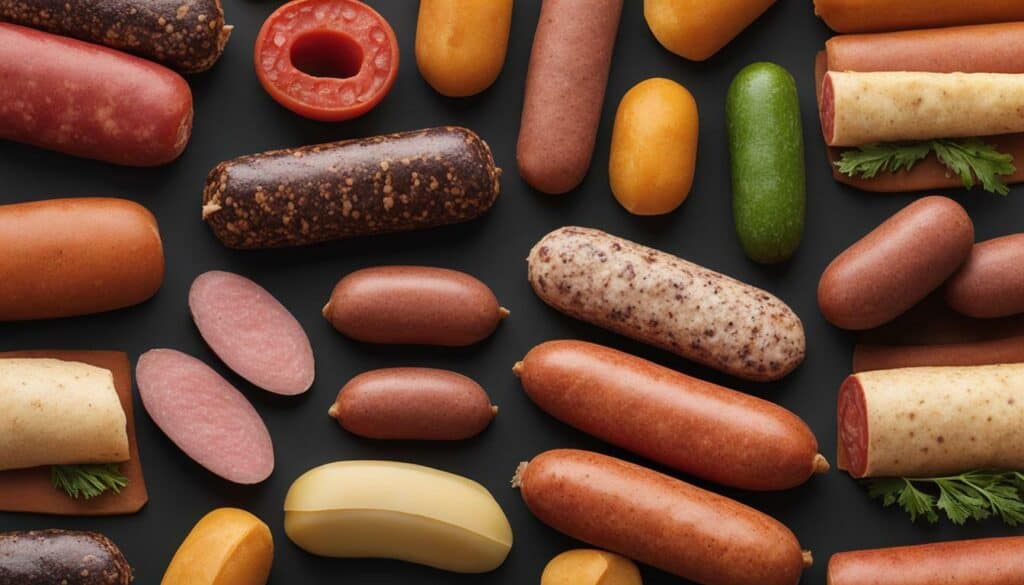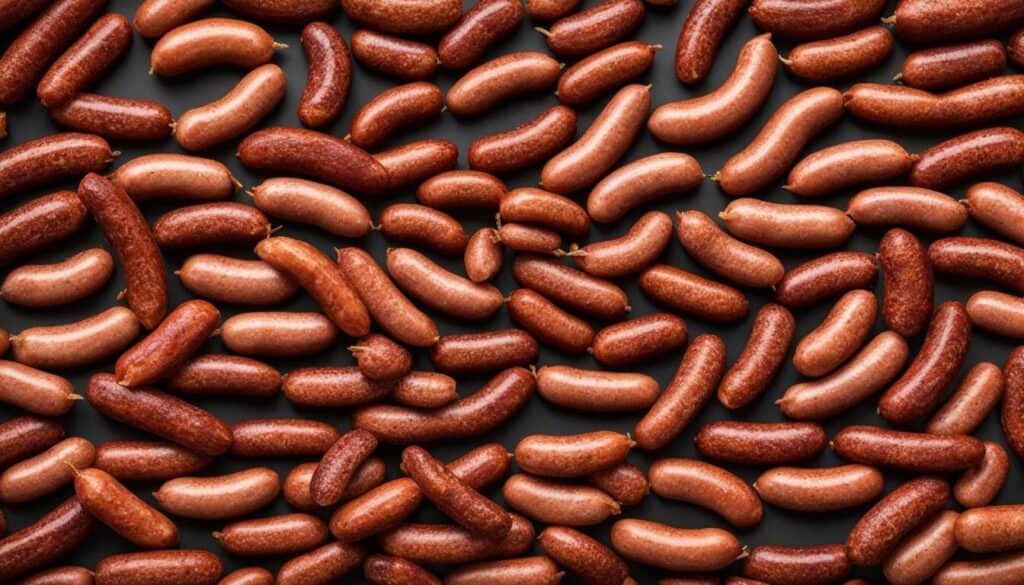Are you curious about the calorie content of small sausages and how they can contribute to a balanced diet? Join me as we delve into the nutritional breakdown of these flavorful favorites.
Key Takeaways:
- Sausages are made from ground meat, fat, and spices.
- Most sausages are high in protein and low in carbs, but some may contain added ingredients that contribute to the carb content.
- Common sources of carbs in sausages include added flavorings and binding agents like breadcrumbs and potato flour.
- On average, sausages contain 0-6 grams of carbs per 3.5-ounce serving.
- It’s important to read the nutrition label for the exact carb content of the sausage you’re consuming.
- Sausage can be part of a balanced diet, but moderation is key due to its high saturated fat and sodium content.
- Leaner options like chicken, turkey, and seafood sausages provide lower fat and calorie content.
- Grilling or baking sausages can help reduce their fat content compared to pan-frying.
- When enjoying sausage, it’s best to accompany it with other nutritious foods.
What Are Small Sausages Made of?
Small sausages are a popular food enjoyed in many cultures around the world, typically made from a mixture of ground meat and spices. This simple combination creates a flavorful and versatile food item that can be enjoyed in various dishes and cuisines. The choice of ground meat can vary, with options such as pork, beef, chicken, or a combination of different meats. The type of meat used can influence the taste and texture of the sausage.
Spices play a crucial role in enhancing the flavor profile of small sausages. Common spices used include salt, pepper, garlic, paprika, and herbs like thyme and sage. These seasonings not only add taste but also contribute to the overall aroma of the sausage. The combination of ground meat and spices is typically mixed together and stuffed into casings, which can be made from natural or synthetic materials. The casings help retain the shape of the sausage during cooking and can add an additional layer of flavor.
To give you a visual representation of the composition of small sausages, here’s a table summarizing the main ingredients:
| Ingredient | Percentage |
|---|---|
| Ground Meat | 70% |
| Spices | 10% |
| Casings | 20% |

Understanding the basic components of small sausages gives us insight into their delicious taste and versatility in cooking. Whether enjoyed on their own, in sandwiches, or as an ingredient in various dishes, small sausages offer a flavorful and convenient way to enjoy protein-rich meat with a touch of spices.
Understanding Carb Content in Small Sausages
While small sausages are generally low in carbs, the exact carb content can vary depending on the type and any additional flavorings or binders used. Sausage is a popular food enjoyed in many cultures around the world. It is made from ground meat, fat, and spices.
Some varieties of small sausages may contain added ingredients that contribute to the carb content. Common sources of carbs in sausages include added flavorings and binding agents like breadcrumbs and potato flour. However, the carb content of sausages is generally low, with most types containing 0-6 grams of carbs per 3.5-ounce serving. It’s important to read the nutrition label to determine the exact carb content of the sausage you’re consuming.

Sausage can be a part of a balanced diet, but it should be consumed in moderation due to its high saturated fat and sodium content. It’s important to consider the overall nutritional profile of the meal and balance it with other nutritious foods. Leaner options such as chicken, turkey, and seafood sausages are available, which provide a lower fat and calorie content. When preparing sausage, grilling or baking it can help reduce the fat content compared to pan-frying. These cooking methods allow the excess fat to drip away, resulting in a healthier end product.
In conclusion, small sausages are a tasty and versatile food option that can be enjoyed as part of a balanced diet when consumed in moderation. While they do contain some carbs, the overall carb content is generally low. By choosing leaner options and preparing sausages using healthier cooking methods, you can further enhance their nutritional profile. Remember, moderation is key, and it’s important to balance your sausage consumption with other nutritious foods for a well-rounded diet.
Common Sources of Carbs in Small Sausages
Added flavorings and binding agents like breadcrumbs and potato flour are common sources of carbs in small sausages. While sausages are generally high in protein and low in carbs, these added ingredients can contribute to the overall carb content. Breadcrumbs, often used as a filler or to enhance texture, can contain significant amounts of carbs. Potato flour, another common binding agent, is derived from potatoes and can also add to the carb content.
Flavorings, such as herbs, spices, and marinades, can also contain small amounts of carbs. These flavorings are used to enhance the taste and aroma of sausages, but it’s important to note that the carb content from these sources is typically minimal.
In some cases, manufacturers may add sweeteners or sugar-based ingredients to sausages, which can significantly increase the carb content. It’s important to read the nutrition label or inquire with the manufacturer to determine if any added sugars are present in the sausage product.
Table: Carb Content in Small Sausages
| Type of Sausage | Carb Content per 3.5 oz serving |
|---|---|
| Beef Sausage | 0 grams |
| Pork Sausage | 1 gram |
| Chicken Sausage | 2 grams |
| Turkey Sausage | 3 grams |
| Seafood Sausage | 4 grams |
It’s important to note that the carb content can vary depending on the specific brand and ingredients used in the sausage. Reading the nutrition label is crucial in determining the exact carb content of the sausage you’re consuming.
While small sausages can be a part of a balanced diet, it’s important to consume them in moderation due to their high saturated fat and sodium content. Opting for leaner options such as chicken, turkey, or seafood sausages can provide a lower fat and calorie content while still offering delicious flavors. When preparing sausages, choosing healthier cooking methods like grilling or baking instead of pan-frying can help reduce the fat content, making them a healthier choice.
Remember, enjoying sausage in moderation as part of an overall balanced diet, accompanied by other nutritious foods, can allow you to savor the flavors while still maintaining a healthy lifestyle.
Typical Carb Content in Small Sausages
Most small sausages contain 0-6 grams of carbs per 3.5-ounce serving, but it’s important to read the nutrition label for precise information. The carb content can vary depending on the type and any additional flavorings or binders used. Common sources of carbs in sausages include added flavorings and binding agents like breadcrumbs and potato flour.
To give you an idea of the carb content in small sausages, here’s a breakdown of some popular varieties:
- Traditional pork sausage: 0 grams of carbs per serving
- Chicken sausage with herbs: 2 grams of carbs per serving
- Beef and mushroom sausage: 4 grams of carbs per serving
- Spicy chorizo sausage: 6 grams of carbs per serving
These figures may vary slightly depending on the brand and specific ingredients used. It’s always best to check the nutrition label for accurate and up-to-date information on the carb content of the small sausages you’re consuming.
When incorporating sausages into your diet, it’s important to consider not only the carb content but also the overall nutritional profile. Sausage is high in protein and can be a valuable source of nutrients. However, it should be consumed in moderation due to its high saturated fat and sodium content. Opting for leaner options like chicken, turkey, or seafood sausages can provide a lower fat and calorie content.
To prepare sausage in a healthier way, consider grilling or baking it instead of pan-frying. These cooking methods help reduce the fat content, making the sausage a healthier choice. Enjoy sausage as part of a balanced diet, pairing it with nutritious side dishes such as vegetables and whole grains.

Sausage can be a part of a balanced diet, thanks to its high protein and low carb content. It is a popular food enjoyed in many cultures around the world, made from ground meat, fat, and spices. While sausages are high in protein and low in carbs, it’s important to note that some varieties may contain added ingredients that contribute to the carb content. The amount of carbs in sausages can vary depending on the type and any additional flavorings or binders used.
Common sources of carbs in sausages include added flavorings and binding agents like breadcrumbs and potato flour. However, the carb content of sausages is generally low, with most types containing 0-6 grams of carbs per 3.5-ounce serving. To determine the exact carb content, it’s best to read the nutrition label of the sausage you’re consuming.
There are leaner options available for those who prefer a lower fat and calorie content. Chicken, turkey, and seafood sausages are good alternatives that provide similar flavors and textures with reduced fat. When preparing sausage, grilling or baking it can help reduce the fat content compared to pan-frying, making it a healthier choice. It’s important to consume sausage in moderation due to its high saturated fat and sodium content, which can be a concern for some individuals.
Table: Typical Carb Content of Common Sausage Varieties
| Sausage Type | Carb Content per 3.5-ounce serving |
|---|---|
| Pork Sausage | 2 grams |
| Beef Sausage | 0 grams |
| Chicken Sausage | 1 gram |
| Turkey Sausage | 3 grams |
| Seafood Sausage | 0 grams |
When incorporating sausage into your diet, it’s important to remember that balance is key. Enjoy sausage in moderation and pair it with other nutritious foods such as vegetables, whole grains, and legumes. By making conscious choices and being mindful of portion sizes, sausage can be a flavorful addition to a well-rounded eating plan.

While sausage can be enjoyed as part of a balanced diet, it’s essential to consume it in moderation due to its high saturated fat and sodium content. Sausage is a popular food enjoyed in many cultures around the world. It is made from ground meat, fat, and spices, which give it its unique flavor. However, these ingredients contribute to its higher levels of saturated fat and sodium.

Saturated fat, found in animal products like sausage, can increase the levels of LDL cholesterol in the bloodstream, which is linked to an increased risk of heart disease. Therefore, it is recommended to limit saturated fat intake to maintain heart health. Sausage also tends to be high in sodium, which can contribute to high blood pressure when consumed in excess. It’s important to be mindful of your sodium intake and choose lower-sodium options when possible.
To enjoy sausage while minimizing its impact on your health, it’s important to practice moderation. This means limiting the portion size and frequency of sausage consumption. Balance your meals with plenty of vegetables, whole grains, and lean proteins. Incorporating leaner options like chicken, turkey, or seafood sausages can provide a lower fat and calorie content without sacrificing flavor. When preparing sausage, opt for healthier cooking methods like grilling or baking instead of pan-frying to reduce the fat content.
Remember, sausage can be part of a balanced diet when consumed in moderation and accompanied by other nutritious foods. By being mindful of your portion sizes and choosing leaner options, you can enjoy the flavors of sausage while maintaining a healthy lifestyle.
Leaner Sausage Options
If you’re looking for leaner sausage options, consider chicken, turkey, or seafood sausages, as they provide a lower fat and calorie content. These alternatives offer a delicious twist to traditional sausages while still delivering on flavor and texture. Whether you’re seeking a healthier option or simply looking to switch things up, these leaner sausage choices are worth a try.
Chicken sausages are a popular choice among health-conscious individuals. Made from lean chicken meat, they are lower in fat and calories compared to traditional pork or beef sausages. With a variety of flavors to choose from, such as spicy Italian or savory herb, chicken sausages provide a versatile option for any meal.
Turkey sausages are another excellent choice for those seeking a leaner alternative. Turkey meat is naturally low in fat, making these sausages a healthier option without sacrificing taste. Like chicken sausages, turkey sausages come in various flavors, including breakfast-style or sweet apple, offering a range of options to suit different palates.
If you’re a seafood lover, consider trying seafood sausages. These sausages are typically made from a combination of fish or shellfish and other ingredients like herbs and spices. Seafood sausages are a great option for those looking for a lighter, yet flavorful, alternative to traditional meat sausages.
Table: Lean Sausage Options
| Sausage Type | Calories per 3.5 oz serving | Total Fat per 3.5 oz serving | Protein per 3.5 oz serving |
|---|---|---|---|
| Chicken Sausage | 120 | 6g | 14g |
| Turkey Sausage | 150 | 8g | 15g |
| Seafood Sausage | 100 | 5g | 12g |
Note: Nutritional values may vary depending on the brand and specific ingredients used in the sausages. Always refer to the nutrition label for accurate information.
Whether you’re trying to reduce your fat and calorie intake or simply looking to explore new flavors, leaner sausage options like chicken, turkey, and seafood sausages are a great choice. Remember to incorporate them into a balanced diet along with other nutritious foods to support your overall health and wellness.

To make your sausage healthier, consider grilling or baking it instead of pan-frying to reduce the fat content. These cooking methods allow the excess fat to drain away, resulting in a leaner and more nutritious meal. Grilling sausage not only gives it a delicious smoky flavor but also helps to retain its moisture. You can cook it directly on the grill or use a grill pan if you prefer. Baking sausage in the oven is another great option, and it requires minimal effort. Simply arrange the sausages on a baking sheet and cook them at a moderate temperature until they are browned and cooked through.
In addition to grilling and baking, you can also experiment with other cooking techniques to make your sausage healthier. Steaming is an excellent option that preserves the natural flavors and nutrients of the sausage. You can steam sausages using a steamer basket or a steam oven. Poaching is another method that involves simmering the sausages in liquid, such as water or broth, until they are fully cooked. This technique helps to reduce the fat content while still keeping the sausages moist and flavorful.
When preparing sausage, it’s important to avoid cooking methods that add extra fat, such as deep frying or sautéing in oil. These methods can significantly increase the calorie and fat content of the sausage, negating some of its nutritional benefits. By choosing healthier cooking methods like grilling, baking, steaming, or poaching, you can enjoy the delicious flavors of sausage while maintaining a balanced and nutritious diet.

Enjoying Sausage in Moderation
Remember, enjoying sausage in moderation, alongside other nutritious foods, is key to maintaining a balanced diet. Sausage is a popular and flavorful food enjoyed by many, but it’s important to be mindful of portion sizes and the overall nutritional composition.
When it comes to sausage, it’s important to consider the fat and sodium content. Most sausages are high in saturated fat, which can contribute to an increased risk of heart disease when consumed in excess. Additionally, sausages tend to be high in sodium, which can negatively impact blood pressure levels. To minimize these health risks, it’s crucial to enjoy sausage in moderation.
However, that doesn’t mean you have to completely give up on sausage. There are leaner options available that can help reduce the fat and calorie content. Consider choosing chicken, turkey, or seafood sausages, which provide a healthier alternative without compromising on flavor. These options not only offer lower fat content but also contain valuable nutrients like omega-3 fatty acids and lean protein.
| Type of Sausage | Calories per 3.5 oz | Carbs per 3.5 oz | Fat per 3.5 oz | Sodium per 3.5 oz |
|---|---|---|---|---|
| Traditional Pork Sausage | 290 | 2g | 26g | 580mg |
| Chicken Sausage | 150 | 2g | 8g | 420mg |
| Turkey Sausage | 170 | 3g | 10g | 680mg |
When cooking sausage, opt for healthier methods such as grilling or baking instead of pan-frying. This helps reduce the fat content as excess fat drips away during grilling, and baking requires less added oil compared to pan-frying. Not only do these cooking methods result in a lighter and healthier sausage, but they also enhance the natural flavors.
Remember, a balanced diet is all about moderation and variety. While enjoying sausage in moderation is certainly acceptable, be sure to balance it with other nutritious foods like vegetables, whole grains, and lean proteins. By making mindful choices and incorporating sausage into a well-rounded diet, you can savor its deliciousness while still supporting your overall health and wellness.

By understanding the calorie and nutritional content of small sausages, you can make informed choices to incorporate them into a balanced diet. Sausage is a popular food enjoyed in many cultures worldwide, and it can be a flavorful addition to meals. While sausages are high in protein and low in carbs, it’s important to be mindful of their saturated fat and sodium content, which means enjoying them in moderation.
Table 1: Nutritional Content of Small Sausages
| Type of Sausage | Calories per Serving | Carbohydrates per Serving (grams) |
|---|---|---|
| Regular Pork Sausage | 210 | 2 |
| Chicken Sausage | 150 | 3 |
| Turkey Sausage | 180 | 1 |
| Seafood Sausage | 160 | 4 |
When choosing small sausages, opt for leaner options like chicken, turkey, or seafood sausages, which provide lower fat and calorie content compared to regular pork sausages. It’s also important to be mindful of portion sizes and limit your intake of sausages that are high in saturated fat and sodium.
To enjoy sausages in a healthier way, consider grilling or baking them instead of pan-frying, as this reduces the fat content. You can also pair sausages with nutritious side dishes like vegetables, whole grains, or salads to create a more well-rounded meal.
Remember, a balanced diet is about moderation and variety, so while small sausages can be part of a balanced diet, it’s essential to include a mix of other nutritious foods as well. By making mindful choices and being aware of the nutritional content of small sausages, you can still enjoy them as part of a healthy and balanced eating plan.

Whether you’re adding sausages to a breakfast plate, enjoying them in a sandwich, or incorporating them into a dinner recipe, understanding their nutritional content allows you to make informed decisions that align with your dietary goals. Remember to consume sausages in moderation and prioritize leaner options for a healthier approach. With a balanced diet that includes a variety of nutrient-rich foods, small sausages can be a flavorful and enjoyable part of your meals.
By understanding the calorie and nutritional content of small sausages, you can make informed choices to incorporate them into a balanced diet. Sausage is a popular food enjoyed in many cultures around the world. It is made from ground meat, fat, and spices, providing a good source of protein. While sausages are high in protein and low in carbs, it’s important to be mindful of added ingredients that may contribute to the carb content.
Common sources of carbs in sausages include added flavorings and binding agents like breadcrumbs and potato flour. However, the carb content of sausages is generally low, with most types containing 0-6 grams of carbs per 3.5-ounce serving. It’s always advisable to read the nutrition label to determine the exact carb content of the sausage you’re consuming.
Sausage can be incorporated into a balanced diet, but it should be consumed in moderation due to its high saturated fat and sodium content. If you’re looking for leaner options, there are alternatives available, such as chicken, turkey, and seafood sausages, which provide a lower fat and calorie content. When preparing sausage, grilling or baking it can help reduce the fat content compared to pan-frying.
Remember, enjoying sausage as part of a balanced diet is all about moderation and incorporating it alongside other nutritious foods. By making conscious choices and being aware of the nutritional profile, you can enjoy this flavorful food while maintaining a well-rounded and healthy eating plan.
FAQ
Q: Are sausages high in carbs?
A: While sausages are high in protein and low in carbs, some varieties may contain added ingredients that contribute to the carb content. The carb content of sausages can vary depending on the type and any additional flavorings or binders used.
Q: What are common sources of carbs in sausages?
A: Common sources of carbs in sausages include added flavorings and binding agents like breadcrumbs and potato flour. However, the carb content of sausages is generally low, with most types containing 0-6 grams of carbs per 3.5-ounce serving.
Q: How can sausage be part of a balanced diet?
A: Sausage can be a part of a balanced diet when consumed in moderation due to its high saturated fat and sodium content. There are leaner options available, such as chicken, turkey, and seafood sausages, that provide a lower fat and calorie content. When preparing sausage, grilling or baking it can help reduce the fat content compared to pan-frying.
Q: How many carbs are there in small sausages?
A: The carb content of small sausages can vary, but most types contain 0-6 grams of carbs per 3.5-ounce serving. It’s important to read the nutrition label to determine the exact carb content of the sausage you’re consuming.
Q: Can I enjoy sausage as part of a balanced diet?
A: Yes, sausage can be enjoyed as part of a balanced diet when consumed in moderation and accompanied by other nutritious foods.
How Many Calories are in Sweet Bread Compared to Small Sausages?
The calorie content of sweet bread and small sausages vary. While small sausages usually contain around 80 to 100 calories per serving, sweet bread tends to have a higher calorie count. On average, a single slice of sweet bread can contain 150 to 200 calories. Monitoring the calorie intake of both options is crucial for those concerned about maintaining a balanced diet.





Leave a Reply